passenger rail - International Railway Summit
After Coronavirus: An opportunity for green mobility in Europe
In March 2020, shortly before the current Coronavirus crisis, the European Commission announced that 2021 would be the “Year of Rail”, in recognition of its potential to be a driving contributor to this mandate’s commitment to achieving its hallmark objective: the EU Green Deal. Europe now finds itself dealing with the ramifications of a widespread public health emergency and its associated economic effects, and rail will be part of the Union’s future recovery and allow it to continue on track towards carbon neutrality. To do so, it is essential that decision-makers at the EU and National levels remain committed to implementing smart, sustainable rail solutions and investing in the development of green technologies that enable them.
The success of any solution relies on its popularity and mobility options are no exception. In recent years, society and individual customers have become increasingly aware of the growing threat of climate change and now seek environmentally friendly solutions. The railway sector needs to continue to prioritise offerings that cater seamlessly to multimodal end-user needs. Providing passengers and freight end-users with more expansive rail mobility services and fostering widespread adoption of digital solutions will be key to creating a future sustainable transport paradigm. The fact that these preconditions must be enacted to create a greener network was given voice by European Commissioner for Transport Adina-Ioana Vălean at the 2020 European Rail Award when she explained that “decarbonizing transport will depend strongly on rail increasing its market share”.
To encourage customers to shift to rail, it is important that rail gives them the tools to tailor it to their needs. Fortunately, our sector is already easily accessible to communities across the EU. Its physical presence in towns and cities positions it as the most natural backbone of a future green mobility paradigm, as it already interacts with other modes of transport offering multimodal services. This infrastructure makes rail most capable of contributing to a sustainable multimodal network by improving ease of travel and implementing systems that facilitate connections. Placing rail as a connective element in the mobility chain will require the implementation of more digital solutions like intuitive ticketing systems and information services across systems. Investing in these technologies allows existing networks to becoming driving forces in the EU’s green transformation.
For the European Rail Supply Industry, continued development of more sustainable and efficient products that keeps rail competitive while contributing to EU Green Deal goals is essential. UNIFE’s Key Enablers, specific research topics deemed potentially most impactful, provide us with areas of focus that will optimise our contribution to this green mobility transformation. Amongst others, these initiatives include digitalisation, new propulsion systems, big data and more. These tools will make rail cleaner and more efficient while increasing capacity and reliability of rail transport. These goals can be achieved through the deployment of existing technologies, such as ERTMS, alongside future technologies delivered by future R&I programmes, like 5G, FRMCS, Digital Twins, and AI. The extension of the Shift2Rail Joint Undertaking (S2R JU) as Shift2Rail2 is essential to fostering and coordinating these efforts going forward as the European Union prepares for a post-COVID world.
The EU Green Deal is an ambitious project that requires a whole-of-society approach to complete. It will only be accomplished with adequate contributions from both the private and public sector, at both the EU and National levels. Strong allocations are needed for HorizonEurope – with sufficient budget for the anticipated extension of S2R JU – as well as the Connecting Europe Facility and Cohesion Fund, to generate and implement sustainable rail technologies and projects that will spur employment following this unprecedented outbreak.
COVID-19 has disrupted public life in ways not seen for decades. As many look forward to a return to their normal routine, the rail sector has an opportunity to anticipate its role as a driver of a cleaner, new mobility paradigm. By partnering the private and public sectors, the European Rail Supply Industry can develop the technologies that will allow us to decarbonize transport and reach carbon neutrality by 2050. Together, the European Union and its rail sector can exit this crisis on a competitive footing while addressing climate change.
From ”flight shame” to ”train boast” – making the most of new opportunities for rail in Sweden
Swedish State Railways (SJ) has for a long time highlighted the minimal climate footprint of rail compared to air travel. More recently, the “flight-shame” movement has emerged as an opportunity to take this one step further. The concept started to gain traction in social media in Sweden in 2017, about a year before climate change activist Greta Thunberg initiated her school strike, which developed into the world-wide Fridays For Future demonstrations. The basic idea behind “flight shaming” was that measures aimed at reducing air travel, such as increased fees for airlines, were insufficient. Targeting the social capital of the travellers would have a greater effect.
Travelling by train in Sweden has increased significantly in recent years. Since the mid 1990s, train passenger kilometres have increased by more than 200 per cent. Just between 2017 and 2019 the increase was another 10.4 per cent. In contrast, domestic air travel seems to have peaked in 2017, with a combined loss of almost 1 million passengers in 2018 and 2019, or -12.5 per cent. Consequently, rail has also improved its market share. These trends continued in January 2020, before the coronavirus crisis hit the transportation industry.
SJ regularly performs on-board surveys asking our customers about their reasons for choosing the train. Among 14 different alternatives, the environmental aspect is now – for the very first time – the top stated reason, mentioned by 34 percent of passengers.
During the past years, SJ has been communicating ”carbon savings” to private as well as business customers, comparing train emissions with corresponding numbers from cars and airplanes. In 2019 SJ decided to further explore the communication opportunities provided by more environmentally conscious customers and the increased interest in travelling by train.
We picked our most important line – Stockholm–Gothenburg – and formed a campaign around a very basic question: “How many journeys by train from Stockholm to Gothenburg can you take before the CO2 emissions equal those of a single flight?”. The answer, “40,000 journeys”, was conveyed in TV commercials, printed media and posters at railway stations. To calculate this number we used the standard methodology for calculation and declaration of energy consumption and CO2 emissions of transport services (EN 16258) and airplane emission data from Scandinavian Airlines1. The fact that SJ is able to purchase 100% renewable electricity, mostly from hydro power, did of course contribute significantly.
Going forward, we now also see a renewed interest in international train journeys. A related Facebook community has attracted more than 113,000 members and it has become a thing to “train boast” – bragging about going on vacation by train. SJ is working to make it easier to book international train journeys. Such journeys usually require some form of collaboration with other train operators, but also with airlines (e.g. for return journeys). Therefore, there are opportunities ahead, not only for rail.
1 SAS have later revised their figures, affecting the calculation of journeys to be reduced to 27,000.
Photo by Tranmautritam from Pexels
Paperless operations to maximize capabilities of rail mobile staff
Salif spoke about the benefits of the Digital Bag at the 8th International Railway Summit in New Delhi
Train drivers, conductors and maintenance technicians are at the heart of railway operations and ensure that passengers (and goods) are transported to their destination in the best conditions of safety and comfort.
They are mobile staff, but still obliged to go to their office to take with them information and papers they need to perform their missions. While it might be good to go to the office to meet colleagues and get fresh news about the company, it also can be perceived as a waste of time that prevents from focusing on core missions. Also, even after having passed by the office, while executing their mission, mobile staff might still miss recently updated guidelines to fully complete their operations. This is also a risk for seamless operations and passenger experience.
Now, let’s imagine a modern, light and user-friendly tool that mobile staff would always have with them and with which, anytime and anywhere they could:
• Consult technical and company manuals to acknowledge all required procedures in manuals
• Receive briefing wherever they are, to prepare their journeys
• Write and send back reports to inform about all events that occur
This vision is a reality with software solutions that enable the digitization of operational processes and, therefore, the removal of paper-based procedures. Immediate outcomes are accelerated data flows and enhanced operational efficiency.
In the aviation industry, for the past 10 years, pilots, cabin crew and mechanics are more and more equipped with mobile tablets and software that support them in the execution of their missions, from preparation to closure.
This major evolution in the way to operate flights generates major business benefits:
• Facilitate transmission of a safety culture since guidelines are more accessible
• Enhance the efficiency of operations: by receiving flight information in advance (or during a flight) on their tablets, crew can anticipate issues and make ad hoc decisions
• Make work conditions better for staff: no need to carry heavy bags
• Improve passenger experience: being always connected, staff can better inform customers
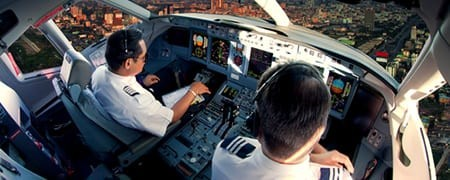
Challenges faced by rail operators are similar to those faced by aviation, so why would rail staff not be equipped with similar mobile solutions so they could benefit from digitized operational processes?
This is exactly what dgBirds offers, via the Digital Bag software solution that is composed of:
• A user-friendly mobile application that can be downloaded and used by mobile staff from iPads. “Documentation”, “Briefing” and “Reports” are the services available from this mobile application
• An administration platform, accessible via any Web browser and from which back office staff can organize, distribute and monitor all documentation to their remote colleagues
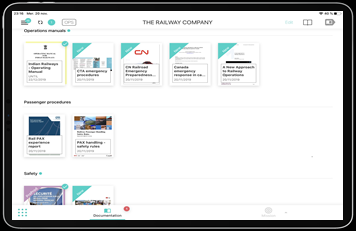
Documentation service: from an iPad, easy access to all documentation and manuals, anywhere, any time
As illustrated below, via innovative services, the Digital Bag can help rail staff better perform their missions, throughout their complete journey:
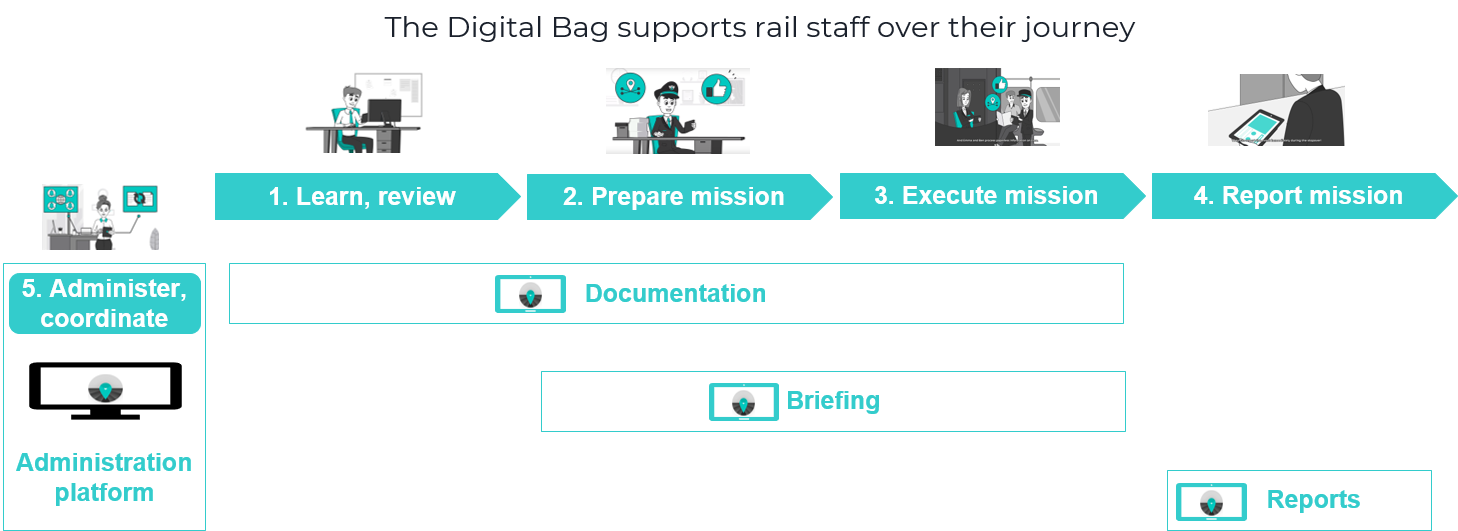
Digital Bag: supports rail staff over their journey
Watch this video to see how the Digital Bag concretely supports rail mobile staff: dgBirds Digital Bag for rail staff
About dgBirds:
dgBirds is a software company based in Paris and is a subsidiary of Air France.
Based on the experience of Air France pilots and cabin crew, dgBirds has developed and proposes a software solution that enables organizations to organise and distribute all the information that mobile staff require during their missions and that they can access from a mobile application.
This value proposition is addressed not only to the air transportation sector but to all transportation organizations that, by definition, have mobile staff who are, on a daily basis, in close relationship with passengers / customers and, as such, are key stakeholders to guarantee the quality of their experience.
contact@dgbirds.com
www.dgbirds.com
The world watches India’s rail renaissance
Formerly one was obliged to travel in India by the old cumbrous method of going on foot or on horseback, in palanquins or unwieldy coaches; now fast steamboats ply on the Indus and the Ganges, and a great railway, with branch lines joining the main line at many points on its route, traverses the peninsula from Bombay to Calcutta in three days. (Around the World in Eighty Days, Jules Verne (1873))
Merely 23 years after George Stephenson’s steam locomotives started commercial operations between Manchester and Liverpool in 1830, Asia’s first rail operation began in 1853 between Bombay and Thane covering 34 km.
Some 165 years on, India’s rail transport has grown to a route length of 68,442km, the fourth biggest network in the world, and transports 8.3 billion passengers and 1.2 billion tonnes of
freight annually1.
India’s love and fascination for these vital arteries and capillaries of the economy has created a unique culture where access to affordable rail transport is protected as a fundamental right.
In this rapidly growing economy, and with a sharply rising population, maintaining existing infrastructure will not be sufficient to keep up with demand.
Infrastructure megaprojects
The country’s first high-speed rail line between Mumbai and Ahmedabad is now under construction, with eight other HSR corridors approved. Urban rail is also high on the government’s agenda: 11 cities have inaugurated metro systems in the last six years, with new metros under construction or being planned in 13 further cities.
The government’s vast Dedicated Freight Corridor project is well underway, with six corridors totalling 9,958km, aiming to shift cargo traffic from road to rail: ‘one DFC train will be able to take as many as 1,300 trucks off the road2.’
Rail electrification will also help India meet its UN climate change pledge. Between 2014 and March 2019, 13,700 km of the network was electrified so 52% of the network now runs on electricity. The government plans to electrify the rest of the broad-gauge network by 2022, meaning 28,000 km will be electrified in the next three years, which will reduce CO2 emissions by 3.4 million tonnes per annum3.
Make in India
New generations of trains are emerging too. Hailed as a game changer, Vande Bharat Express ‘Train 18’ entered into service in February 2019, and it now runs on two routes from
New Delhi. India’s first semi-high-speed intercity EMUs, which travel at a top operational speed of 160 km/h, were designed and built domestically by Indian Railways’ subsidiary
Integral Coach Factory (ICF), making it a flagship project under the government’s Make in India campaign.
It was reported in October 2019 that an international tender for 60 new 160km/h EMUs was about to be announced. The media report stated that the trains would be delivered by 2022 at an estimated cost of Rs 380 billion (USD 5.3 billion). Seven trains would be imported, with the remainder to be manufactured in India4.
In July 2019, plans to seek private investment to part fund the Rs 50 trillion ($700bn) required up to 2030 were announced. Part-privatisation of rail operations in India has also been widely discussed to inject much needed cash into the infrastructure.
Window to the world
The global railway sector is making a transition from a domestic-oriented, inward-looking culture to an international network of operations, a global supply chain, multimodal partnerships and cooperation with international peers who face similar challenges.
International Railway Summit advocates free exchange of people, goods and ideas. By hosting these meetings, we help rail operators learn about the latest trends and best practices, we introduce innovative solutions to those who are looking for them through online matchmaking and one-to-one meetings and we facilitate networking between peers and potential partners.
As India enters a new era of rail globalisation, international governments, rail operators and
manufacturers have shown much interest in forging partnerships. I hope that this summit will help deepen international ties between the participants.
The 8th International Railway Summit in New Delhi, India, is a unique networking event featuring a two-day conference programme delivered by sector leaders, bespoke one-to-one meetings, site visits, and a variety of formal and informal functions. The summit takes place from 20-22 November 2019.
Our thanks go to all speakers and sponsors contributing to the event. We are grateful for the kind support we have received from the Ministry of Railways of India in planning this summit and organising the technical visits to New Delhi railway station and the train control centre.
We are honoured to welcome the EU Transport Commissioner Violeta Bulc, and Chairman of the Railway Board, Ministry of Railways, India, Vinod Kumar Yadav, as keynote speakers at IRS8, amongst a particularly impressive line-up of Indian and international dignitaries.
Finally, we would like to thank our long-standing supporting partner, International Union of Railways (UIC) and their Director General François Davenne and Director of Rail System Christian Chavanel for valuable counsel and backing of our cause.
1 Indian Railways Year Book 2017-18.
2 Indian Railways Year Book 2017-18.
3 Ghanshyam Singh and Bhupender Singh Bodh, ‘Towards a greener future’, Railway Gazette, May 2019.
4 Srinand Jha, ‘Indian Railways to procure 60 new trains’, International Railway Journal, 7 October 2019.
The Next Rail Revolution is Here – and the Future is Digital
Jean-Francois spoke about where the rail sector sees itself in a few decades time, and what the endgame of digitalisation could and should be, at the 7th International Railway Summit in Frankfurt
“Digital Railways” doesn’t have quite the romantic ring of the great train services of the past – the Orient Express, the Canadian Pacific or the Trans-Siberian but Digital is the next big wave in the railway sector and train users and operators can look forward to higher service standards ultimately improving efficiency and reliability of railway systems.
A new golden age of rail travel
Railway networks in many countries have become extremely dense, especially on commuter lines in major cities, making it difficult and costly to implement major upgrading projects. Instead, the kind of improvements in efficiency that digital technology excels at can have massive operational impacts.
In fact, digital technologies hold out the promise of true transport integration, linking main-line rail services with other urban transportation modes, enhancing efficiency and passenger convenience. The introduction of Information and Communications Technologies (ICT), Intelligent Transport Systems and open-data/ open-source transport applications are transforming urban transportation, optimising the efficiency of existing and new urban transport systems, at a cost much lower than building new infrastructure from the ground up.
New transport data collection technologies are also being deployed to provide information about delays, downtime and predictive maintenance which could lead to huge improvements in service standards, safety, and unlocking the potential of railways. Passengers will also be able to make real-time decisions about their journeys based on the features that matter most to them such as reliability, safety, travel time and cost. What’s more, railways today offer a connected service all along the passenger journey with on-board wifi for internet and entertainment options.
Other positive aspects of railway digitalization highlighted in a European Railway Review interview include the opportunities digital technology offers for cleaner air as well as the tangible benefits to travelers of increased flexibility and convenience. Enhanced safety, predictive maintenance and automated driverless operation are all part of rail’s future.
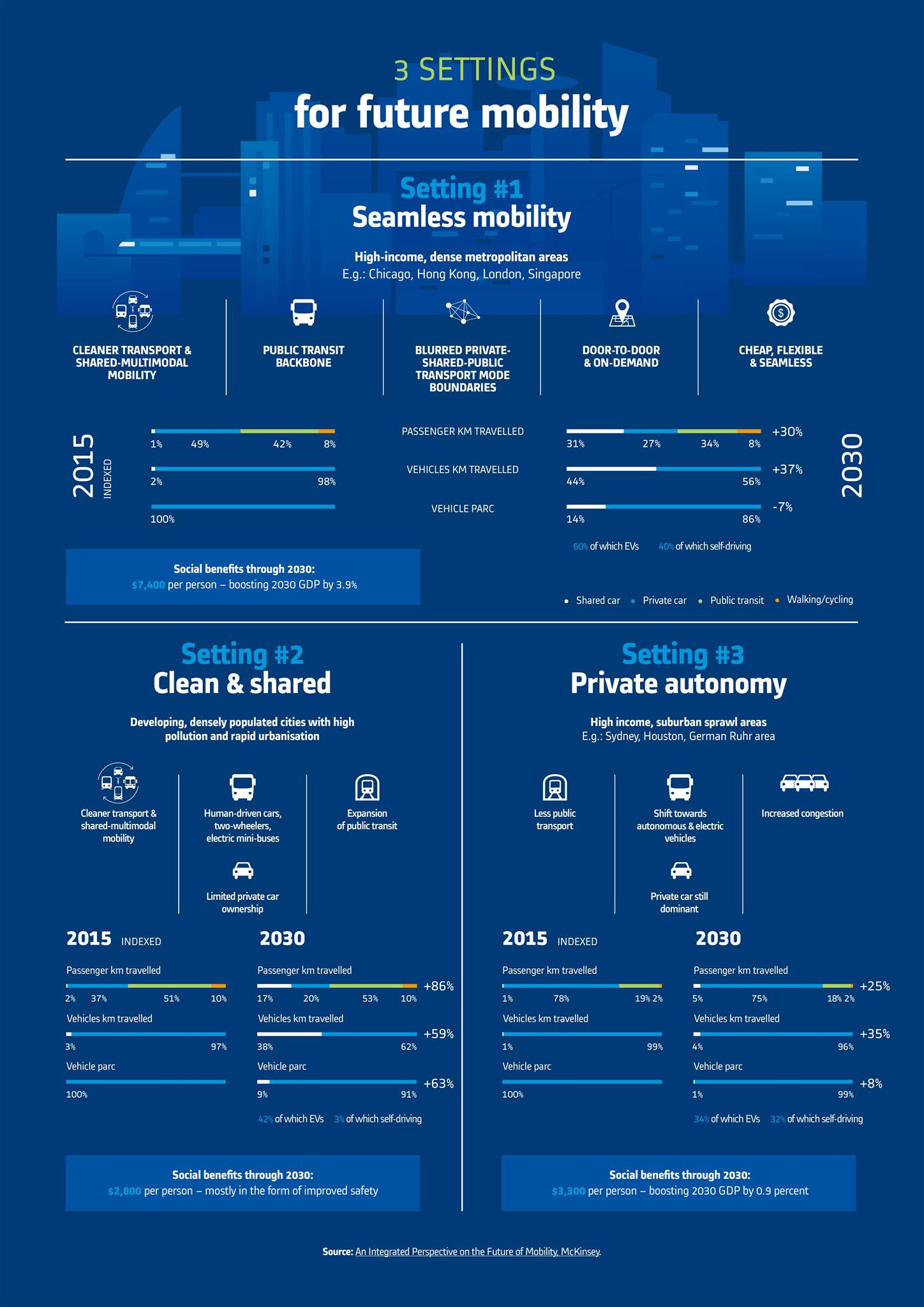
Mastria: Alstom’s multimodal traffic orchestrator. ©Alstom
How do we get there?
The path to digitalisation will not, of course, be entirely smooth. The “Connected trains” survey by management and technology consultancy BearingPoint found that a digitalised and integrated rail system with connected trains is the future, but it will require collaboration and coordination to get there.
Digital technology in the railway sector will see a shift from the traditional emphasis on heavy engineering, to software and data handling skills. There will always be a place for traditional rail engineers, but demand will grow for data management talent, as digital signalling technology unlocks capacity on complex mainline networks.
With new ways of working and new technologies, industry collaboration and effective business change will be more important than ever. Rail operators should take this digitalisation opportunity to integrate different mobility options into their existing offering and consequently focus on value creation through innovation. Without a doubt, it is the quiet efficiency of digital technology that will take rail systems and their passengers into a new age of rail travel that is safer, more convenient and comfortable, more economical, and more climate-friendly.
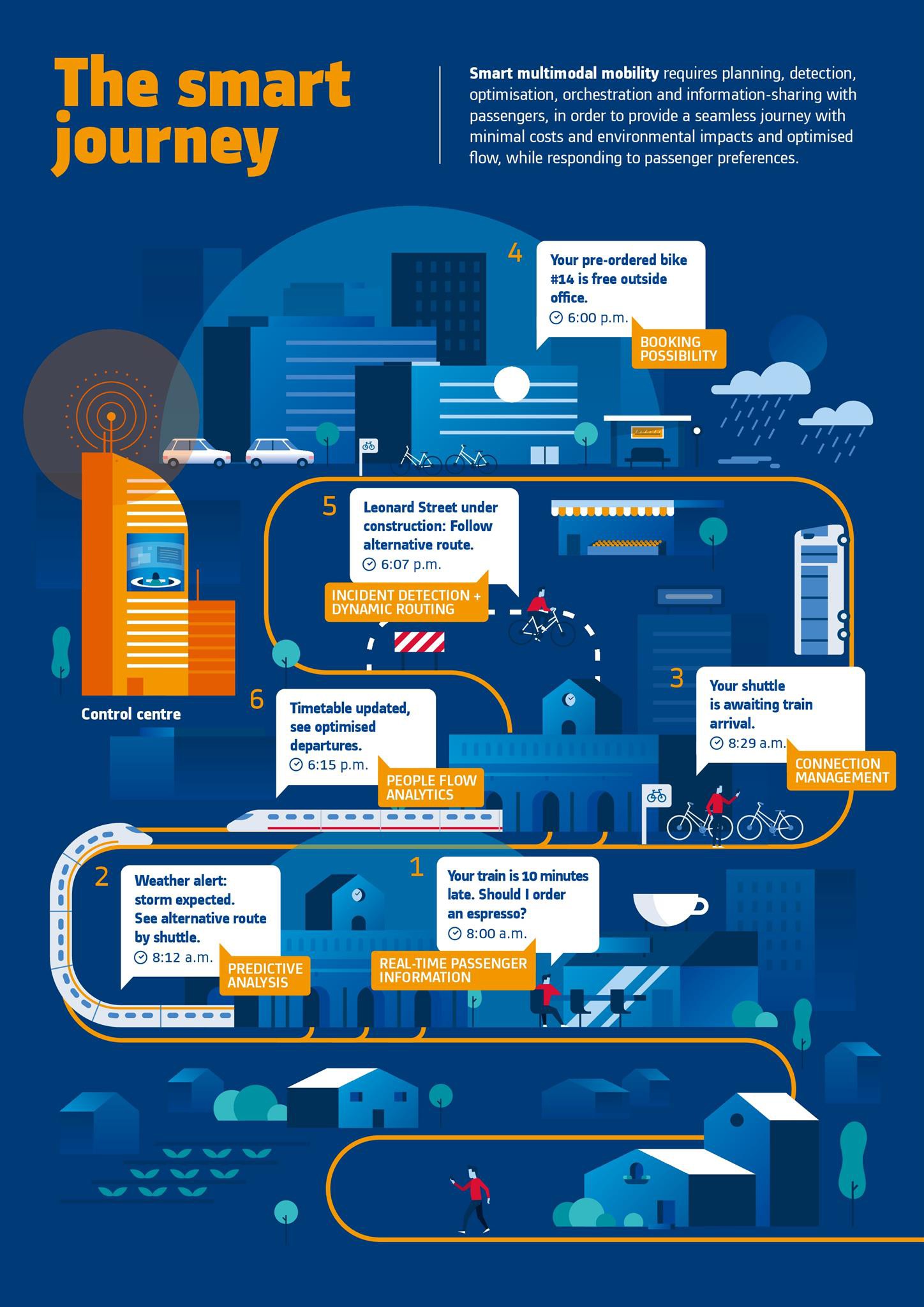
Mastria: Alstom’s multimodal traffic orchestrator. ©Alstom
Making the most of the digital revolution
Jean-Pierre spoke about how rail systems could meet the mobility challenges of the future, about the economic implications of high speed rail, and about whether HSR was delivering on its promise of improving society, at the 4th, 5th, and 6th International Railway Summits respectively.
Jean-Pierre will speak at the 7th International Railway Summit about how digital technologies can enable smooth cross-border travel and trade.
The first thing to note is that rail appears as a key factor in the 21st century world.
Rail is essential but in complementarity, not competition, with other modes, as the backbone of a new mobility chain.
Rail from its origin has survived various revolutions:
- The industrial revolution at the very beginning
- An energy revolution in the 70s
- An information technology revolution in the 80s – 90s
Today, we are now facing the so called 4th revolution: A digital revolution.
This revolution is generating very strong impacts on all decision-making processes, all production and maintenance processes and obviously on the whole information chain itself.
Rail must obviously profit from this technical revolution in order to rapidly and efficiently improve productivity, security and services thanks to connectivity.
One key word is “speed”, since we currently face very strong demands from the markets.
These markets can be intra-urban markets, inter-urban, inter-regional or even inter-continental markets if we consider the emergence of large inter-continental corridors.
Nowadays decision-making cycles are faster and faster. This can be seen as being in contradiction with the operating modes of rail, since investments are really important considering the size of their deployment, and the long cycles of ROI.
These rapid developments obviously demand new approaches and new competencies directly linked to the information domain.
But these have to remain fully compliant with rail technologies and the complexity of its system.
We must admit that, today, the rail sector, whatever the economic context might be, is running out of the resources that would allow the development and the implementation of these new emerging technologies.
Considering this statement, we definitely have to adopt new modes of cooperation.
- Intermodal partnerships have to be enhanced in order to mutualize potential impacts on interfaces, and on shared customers.
- Incubators allow us to work in a different way: Focus on research; Anticipation with the development of Proof of Concepts, demonstrators etc. Innovative funding modes have to be considered as well.
- Links with universities since it is in their hearts and minds, their talents, that the needs of the market, of their market, will be expressed tomorrow. They are the ones who will answer these demands with the emergence of new expertise.
That is the reason why UIC works in close partnership with major actors such as UITP, UNFCC or IATA, why we have developed a Digital platform and an Alliance program with Universities.
Such collaborations enable a better design of our interfaces and the provision of seamless information to our customers, whether Freight or Passenger.
We wish to, and must, open this 19th century pyramid focused on closed working methods and create new circuits open to the outside world, with new partners and relays.
Does competition benefit customers?
Carole took part as a speaker at the 6th International Railway Summit in Prague in a panel discussion addressing whether competition benefits customers. Carole represented the perspectives of the private and independent freight operator members of the European Rail Freight Association (ERFA).
The European Rail Freight Association (ERFA) is an association which represents private and independent railway companies from across Europe. ERFA aims to achieve the best conditions for a competitive railway sector. Our mission is to promote rail transport as a first and viable choice for customers, and to ensure full market opening of rail across all of Europe. ERFA’s objective is to represent the voice of new market entrants in Europe. We support the EU decision-making process with a focus on policy and technical affairs. Our focus is on generating growth for demand in rail services and shifting more goods onto eco-friendly rail.
We represent more than 1/3 of the rail freight market share.
ERFA’s existence and activities are based on this conviction: competition in a healthy environment benefits customers. Our members are competing between each other for customers because they are convinced that they can bring an added value to customers, and their continuous growth has demonstrated that they can.
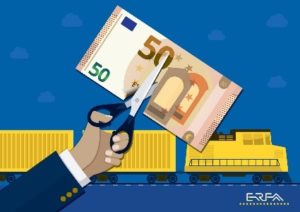
Within ERFA, we favour competition as away to meet customer needs. European policy takes note that a monopoly situation fosters pricing distortion: limited customer orientation and unsustainable business models. Let’s take for instance the French situation audited in the Spinetta Report that concludes that the current SNCF business model has to be adapted and that competition has to be developed on the French market.
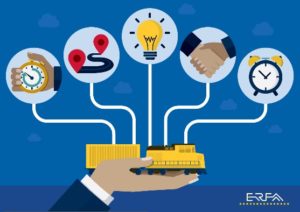
Competition and the existence of private operators on the market have many advantages. Among them, monopoly service providers will never have the same pressure to decrease prices, improve quality, innovate, as when they are competing with other companies for customers. Better quality creates pressure for higher performance. Also, better price drives down costs.
Moreover, we have in mind that innovation is beneficial to drive the development of superior products for the market. We think that information availability creates the climate for enhancing customer communication. We want customers to have the power to make choices: if a customer is unhappy with one Railway Undertaking, he has other options.
To conclude, competition in a healthy Market environment benefits customers; but healthy competition is still not the case in most EU countries today! In most EU countries one dominant market player, normally the state-owned incumbent, trounces the competition with the nearest, biggest competitor trailing far behind. This should be not the case if the right framework conditions were in place to support sustainable business models for freight. So yes, rail freight is open to competition today, but still not able to deliver the products needed by the market.
Handling congestion and an evolving demand in Paris
Thierry spoke at the 5th International Railway Summit in Kuala Lumpur about the challenges of congestion and demand facing Paris and RATP, and the solutions being implemented and proposed
The Paris Region and its transport operator RATP are responding to an evolving mass transport demand by improving the existing system, and building a brand new ring rail road.
Ten years ago, the Paris public transport system featured a dense network of downtown metro lines mainly dating from the early 20th century, with two regional rapid transit (RER) lines, built in the 1970s, bisecting the city and linking it to its suburbs. The system was struggling to cope with a combination of increasing congestion and mobility demands that were evolving significantly.
People used to travel into Paris from the suburbs to work, but the arrival of new business clusters in the region has created urban sprawl in previously rural areas. 70% of the adult population now commute from suburb to suburb, a 50% increase since the 1980s. With hardly any orbital public transport available, they either use their cars on a congested road network, or take the RER through the middle of Paris, thereby overcrowding lines that are already saturated at peak periods.
So the double challenge for Paris and RATP has been to increase capacity on the existing network, and to better serve the needs of passengers travelling from suburb to suburb.
Driverless metro lines have played a major role in improving capacity: following the success of Line 14, Paris’ first automated line that opened in 1998, Line 1 was automated in 2011, and the automation of Line 4 is underway. Automation has cut headway by 20%, increased commercial speed through more controlled acceleration and braking, and considerably reduced per km compared to a standard line.
Train shapes have been designed to increase passenger capacity with new interior layouts on metro rolling stock offering new seating arrangements and more standing room, and double-decker RER trains bringing 30% added capacity.
Unlike the older underground lines whose stations cannot be lengthened, Line 14’s stations were built to anticipate longer trains, so when the line upgrades from 6- to 8-car trains in 2019, and then extends north and south in 2023 and 2024 respectively, it will increase its passenger capacity by about a third, to reach a total of one million passenger journeys per day.
To link Paris’ close suburbs, RATP is rebuilding its tramway network with 11 new light rail lines, that also act as feeders into the metro and RER. To link the more remote suburbs that have grown around the new business clusters, the authorities are launching a major orbital metro network, the Greater Paris Express.
The project will open in several phases from 2022 to 2030, with the extended Line 14 as its backbone, and once completed, its high-capacity driverless trains will operate on 205 kilometers of line, linking 72 multimodal stations and transporting 2 million passengers daily.
In Paris, RATP is helping to solve the challenges of sustainable mobility by combining increased capacity with new orbital public transport solutions. RATP Dev is an RATP Group subsidiary set up in 2002 to help other cities outside Paris and France face similar challenges. As a world leader in Driverless Operation, with 16,000 employees in 14 countries worldwide, we at RATP Dev are well-equipped to work with cities that want to be less congested and polluted, and more attractive and efficient.
Leveraging the Internet of Things to enable a smart rail infrastructure
Etienne, networks and telecommunications expert at Thales Ground Transportation Systems, presented how the Internet of Things (IoT) can improve operational and monetary efficiency at the 5th International Railway Summit in Kuala Lumpur.
The railway industry is going through a digital transformation due to recent challenges around increased competition from other transportation methods while coping with limited resources.
Better performance is expected to satisfy the increasing traffic demand in congested cities, leading to optimum utilisation of existing infrastructures. Achieving this within decreasing budgets means better returns on assets, simplified wayside systems and lower maintenance costs. Meanwhile, required efficiency improvements call for more integrated Operation Control Centres, automated with new data-driven functionalities, enabling infrastructure operators to quickly react to incidents. Finally, improving passenger experience is fundamental, while maintaining compliance with safety regulations and cyber security to mitigate new threats created by digitalization.
Rail Infrastructure Managers must at the same time:
• Improve safety conditions and reduce service disruptions,
• Maximize asset availability and increase operations efficiency,
• Optimize the financial return on assets and manage decreasing overall budgets.
This leads to stringent operational requirements for rail infrastructures. Achieving this requires a paradigm shift. To succeed, the industry must develop decision support tools that provide a comprehensive view of the infrastructure and integrate information from increasingly disparate systems. All this leads to smarter maintenance regimes – moving from break and fix to predict and prevent.
This in itself is nothing new. Defence, Aeronautics and Space have developed Health and Usage Monitoring Systems (HUMS) to increase availability and minimize breakdown risks. Applying this model to the railway industry enables predictive maintenance, where failures are anticipated and repaired before service disruption, optimising not only performance but also safety and cost.
These new capabilities rely on new technologies such as the Industrial IoT, Big Data Analytics and Cloud technologies. Data generated by sensors is collected through versatile networks fit to field conditions, then fed into a cloud infrastructure supported by Big Data Analytics frameworks.Relying on Artificial Intelligence and Deep Learning algorithms, data scientists and subject matter experts combine technical savvy and unparalleled interpretation skills to create insights.
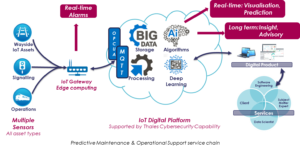
Transforming raw data into knowledge is not easy though. This requires strategic choices like sensors with proper data normalization and formatting, and efficient diagnostic rules. The network and IT architecture should use a good balance of distributed and centralized processing, relying on a scalable IIoT platform, modular enough to accommodate technology evolutions and context-specific operational choices. Cybersecurity is, of course, central to the solution, from sensors up to the application front-ends. These solutions must be scalable with real-time capabilities to enable fast response. A consolidated view of the information also supports immediate monitoring and long-term strategy.
The Industrial IoT model will help railway industry to benefit from predictive maintenance, real-time diagnostics and long-term process optimization. From an integrator’s standpoint, modularity and independence from technology are paramount to ensure future-proofing, and adaptability to diverse Rail Infrastructure manager’s needs.
Then a predictive maintenance solution will significantly improve maintenance costs, downtime and unplanned events. For the maintenance teams, this will also improve work conditions, focussing on high value tasks. Eventually, right-first-time repairs, enabled by accrued anticipation capacities, will minimize time spent on trackside and increase safety conditions.
Competition and excellence as keystones for the success of regional passenger rail
Erich, CEO of open access operator WESTbahn, spoke at the 4th International Railway Summit in Paris of the vital importance of competition and excellence in meeting customer needs and enabling regional passenger rail to thrive
The European Commission prepared a sophisticated roadmap to more competition in the rail sector with “The White Paper on a Single European Transport Area” in 2011, knowing that only more competition guarantees more excellence in regional passenger rail. Because of the legislative process of the 4th Railway Package sufficient compromises were made since member state politicians and CER (representing incumbents) concentrated on prolonged possibilities for direct awards.
Nevertheless, long lasting direct awards do not support quality and excellence. There is no need to push towards higher quality goals if everything is agreed upon in advance without competition.
The clue to quality improvements in regional traffic is competition – as proven in several other industries.
Example: Austria, with WESTbahn as the only competitor in long distance passenger rail traffic:
100% of PSO contracts in the past were direct awards and currently there appear no signs of change in the attitude towards competitive tenders.
WESTbahn started in December 2011 an hourly service between Vienna Westbahnhof and Salzburg. 5 years later, from December 2017, WESTbahn will more than double its fleet and start a second line between Vienna Main Station and Salzburg – the first private half hourly tact system (competing with a state railway) in Europe.
Steady increasing train-kilometer and passenger volumes, 99.9% train availability, 95.2% punctuality (2016) and perfect personal service on board (up to 8 stewards per train in peak hours) mark WESTbahn out as a top-quality provider. Annual customer satisfaction surveys show that customers are very satisfied with WESTbahn’s service and this USP will be transferred to WESTbahn’s new line and hopefully soon to regional traffic, for which WESTbahn is impatiently waiting to get the chance to show its excellence.
WESTbahn has repeatedly demonstrated two major skills – the ability to compete with an incumbent of multiple size who receives subsidies for 80% of its services and the expertise to rank first within the travellers´ relevant set due to highly focused customer orientation.
Quality improvement in regional traffic can happen easily and fast once Austria decides to start tendering in rail regional PSO’s.
WESTbahn is eager to prove its competence and success also in regional traffic with a new approach:
- WESTbahn has an extremely lean and cheap overhead
- All funds only for customer related elements
- Crew on board stands for service, safety and satisfaction
- New production and train redundancy efficiently secures lower costs